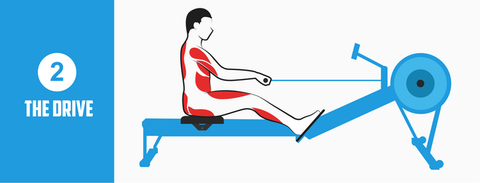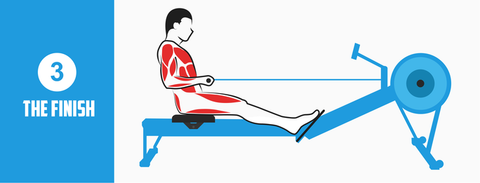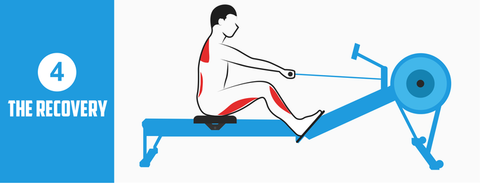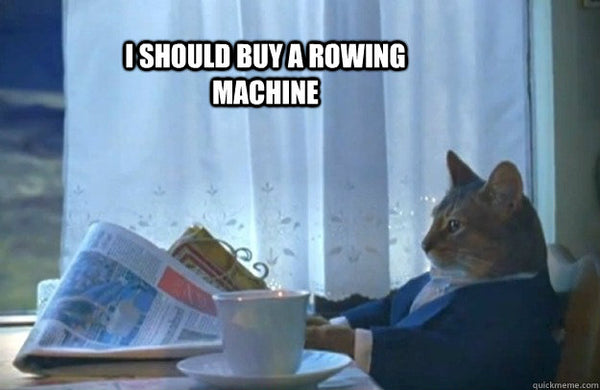How to Use a Rowing Machine
Posted by Hornet Watersports on
Rowing machine
The rowing machine has the potential to be intimidating to those who haven't had much practice. However, it is a great way to make your cardio routine more exciting once you have had a little practice.
This machine is very effective for strengthening legs and the all important core. It’s also great for burning calories. One thing we have to be very careful of when using this machine is any possible back injuries that can result. This type of injury can be avoided however, with the use of proper form and technique.
Before we get into the instructions, please be aware of the following:
You don’t want the fabric from your clothing getting caught in your machine while you are using it. To prevent this, remember to wear form-fitting clothes.
If you are a beginner, try setting 2 or 3 to start out and keep your strokes-per-minute (SPM) relatively low as well. SPM of around 20 - 25 is a good place to start out. Those rowers with more experience usually set the machine at around 3 - 5.
Use your display button to choose the right measurement that is appropriate for you. Whether you are trying to measure kilometers traveled, or calories burned, or one of the other settings, your workout can be measured in different ways.

Get your Rowing Machine Seat Cushion here for $19.99!
How to Row on a Rowing Machine
Instructions for Beginning Position
- Set the resistance low for your first rowing sessions. Slowly but surely, increase the resistance as you figure out what works best.
- Your feet shouldn’t move around while you are doing your sliding. Make sure you secure your feet on the pads and tighten the straps.
- Raise both your knees and then slide to the top of your concept 2 rower. Use your hands to grasp the handle using an overhand grip. Do not hold on too tightly, however.
- As you slide to the end of the rowing machine, pull the handle with you. You want your legs to be straight. However, knees should still have a slight bend in them; don’t lock your knees. Lean back a little bit and then pull your hands to your chest area. Hold the handle so it is right below your chest. Your elbows should be pointing down against each side of your body. This is not only the position where you should begin your workout, it is also your ending position after you complete a full stroke with your rowing machine.
Instructions for the next step: “The Catch”

- First move your arms out, and then your upper body. Do not slump your back - it should always be straight. Also very important, your shoulders will be back and your abs engaged throughout your motion.
As your body leans forward, and your arms extend, slide your body forward on the seat -- do this by bending your legs. Once you reach the top of the machine, your legs will be bent and your arms will be fully extended. This part of the stroke is called the catch.
Instructions for the next step: “The Drive”

- To slide back to your final position, the first thing you want to do is push off with your feet. Your legs straighten but your arms are still extended. Your body should still be slightly leaning forward (see picture). The “drive” position is the part of the workout that looks very much like pulling oars out of the water to propel a boat forward. Your core will get a great workout.
Instructions for the next step: “The Finish”

While you keep pushing with your legs, move your upper body, starting to lean back (see picture).
- Your arms are the last remaining body part to return to finish position. As your upper body goes back, pull the handle and bend your arms. This way, the handle ends up back to touching the front of your chest, the same way you started. Gripping the handle hard should not be necessary because the power should be found in your legs. Using too much force pulling the cable can cause blisters, but worse it can also cause back problems.
Instructions for the final step: “The Recovery”

- Until you are accustomed to the rowing machine and how it works, continue practicing your stroke at low resistance, nice and slow. If you are having trouble getting the hang of it, break the moves down into a sequence: arms-body-legs as you pull up to the top of the machine and legs-body-arms as you push back.
The authors of this content would like to remind you that if you have any concerns about your ability to perform these exercises without injury, please contact a professional. This content is not meant to substitute for any professional guidance.
The effectiveness of rowing and benefits for your body
It is very difficult, or perhaps impossible, to think of a cardio machine that works more effectively than an indoor rowing machine. Your upper and lower body are both going to exert similar effort. In order to do all the repetitions required by a workout on this machine, not only is your best cardiovascular fitness effort is going to be required, but your muscles will have to endure a tough regimen.
Rowers are also great for fat loss. A relatively short 30 minute workout can burn between 200 - 400 calories! You won’t find this kind of efficacy with most workouts.

Get your Anti-slip Rowing Machine Cushion for Concept 2 machine here for $24.99!
Rowing doesn’t have to be your entire workout. It can be an excellent warm-up. For example, if you are a runner, rowing for 10 minutes before your run helps get your blood flowing. It’s also a great warm-up for weight-lifting. The lifts may be more challenging after a rowing session, but your muscles will get a lot more out of it.
It is very common for even the most dedicated fans of fitness to get bored with their routines from time to time. Another benefit of rowing is that you will be able to add some nice variation to your workout. Do you love to run? Are you an avid cyclist? Do you find yourself on the treadmill when it’s cold outside? Rowing is a great change of pace! In addition, it is less aggravation and stress on your joints.
Another great benefit to rowing is that if you are an professional or ametuer athlete, rowing regularly is going to make you a more explosive competitor. Whatever the specialty sport, athletes find that their speed and agility is much improved when they add rowing to their workouts.
Many experts have weighed in on the many benefits of rowing. Garrett Roberts, a well-known an exercise physiologist and personal trainer in the U.S. said the following:
"Rowing is a full-body exercise, and it keeps the heart rate elevated... but then it's leg press after leg press and row after row, so there's a huge strength-training component to it too….Rowing burns two to three times the amount of calories of Spinning… Unlike a bike, which only has resistance in one direction, rowing has resistance in both directions—forward and back—making you much stronger and increasing the rate at which you burn calories."
With experts like Mr. Roberts singing the praises on rowing machines, it’s easy to understand why you can find them in almost every comprehensive gym in the United States and beyond.
Hornet Watersports has an extensive product line for indoor rowing, including cushions, gloves (black or pink), rowing machine covers, and more. Many of these products can be purchased in standard size or extra-large. They can be found in black, pink, yellow, red, and blue. If you have any questions about these products, please call Hornet at (207) 710-0130
Or send an email to info@hornetwatersports.com
0 comments

